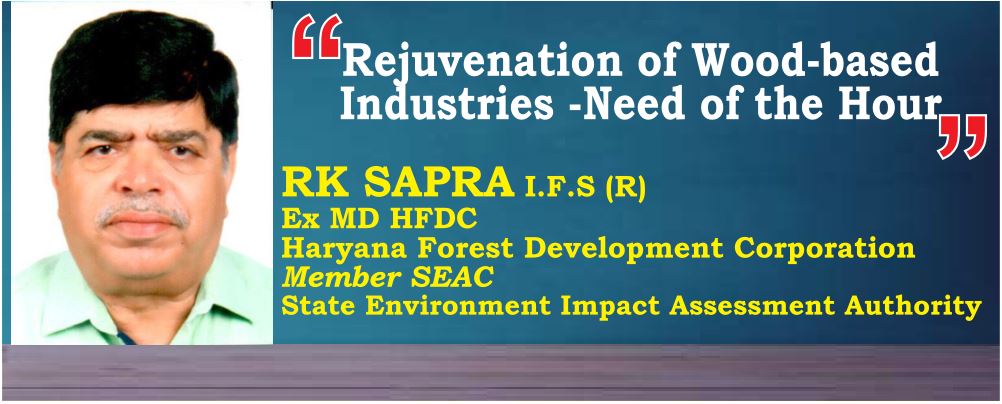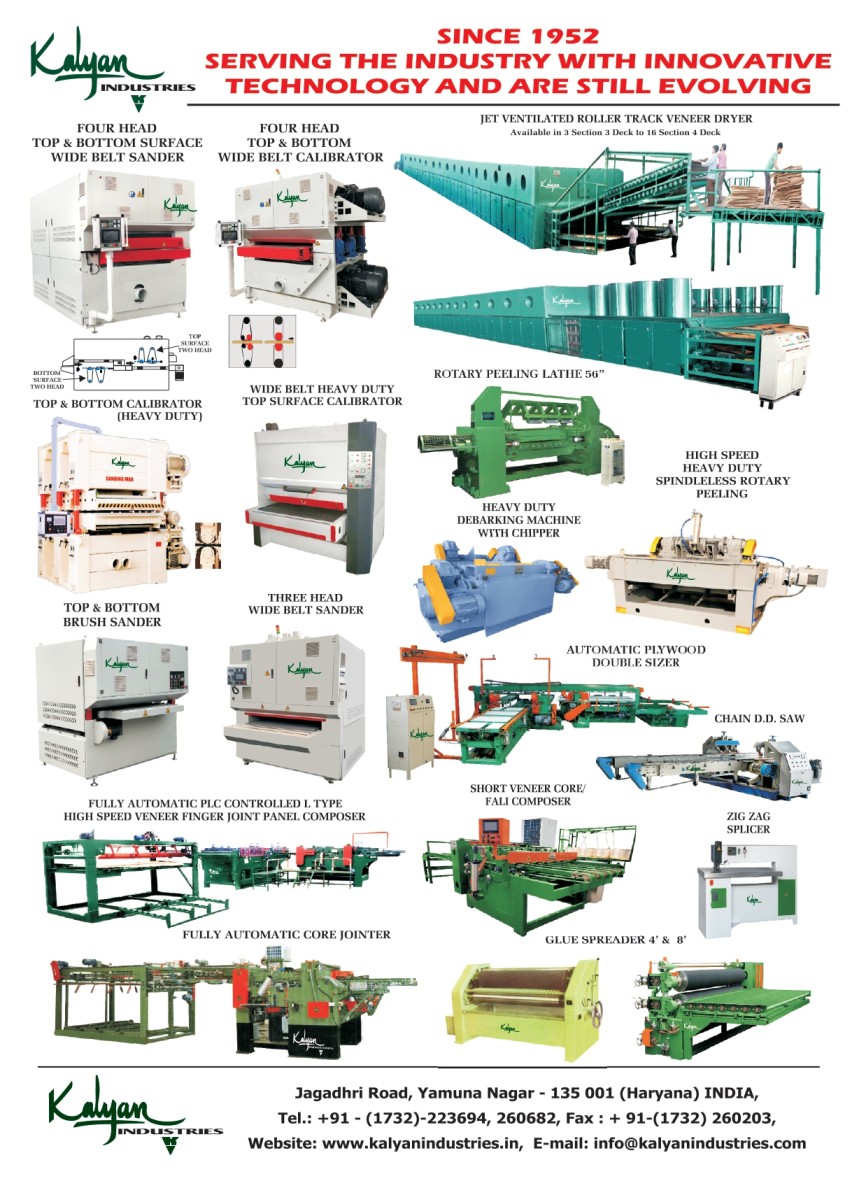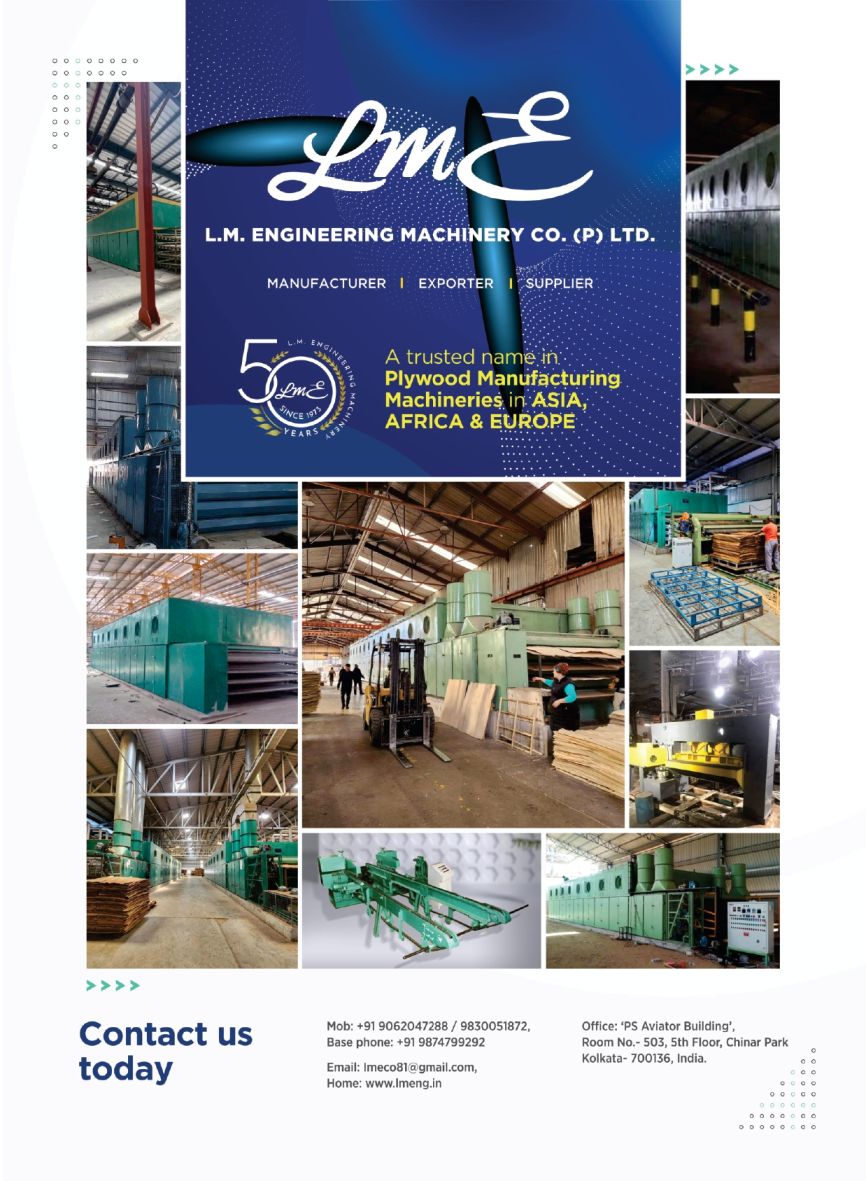
R.K. SAPRA I.F.S (R)
- जनवरी 17, 2021
- 0

Last month we have studied
1. Status of wood based industries
2. Integrations of Agro forestry and wood based industries
3. Import and export of wood and wood products.
Concluding and remaining of the article:
How to Increase Wood Production?
To increase production of large sized timber, degraded forest areas in our country can be better utilized through raising of medium (kikar and ailanthus) to long (teak and shisham) rotation plantations through use of better quality planting stock and improved silvicultural practices. If twenty lakh ha of degraded forests is brought under improved plantations which might yield annually about 1.0 crore cum of timber worth about Rs. 16800 crore and generate employment of about 500 lakh person days (author’s e stimate). These plantations may be financed either by the Government or through public private partnership. The second option seems more feasible as the forestry sector has always faced the financial crunch due to lower budgetary allocations. Alternatively, these plantations may be raised on cultivable wastelands and current fallows under contract farming. As the imported timber may become costlier in future due to strict enforcement of forest certification regime, so increasing domestic production of timber and promotion of composite wood panels may be the right strategy in the long run.
To increase production of small sized timber, ten lakh ha of farmlands may be brought under short rotation (poplar, eucalyptus and Malabar neem) plantations, which will yield annually about 1.9 crore cum wood worth about Rs. 9,900 crore and generate employment of about 800 lakh person days (author’s estimate). The comparatively high income from farmland plantations has generated healthy competition with agricultural crops, however, the area under agroforestry fluctuates depending upon their relative profitability. Hence, it is high time that integrated models of agroforestry and wood-based industries are promoted. Secondly, enforcement of forest certification may be ensured, which will restrict the import of illegal timber that will directly help the farmers in getting better prices of farm-grown wood.
Foreign Direct Investment in Wood-based Industries
The major furniture manufacturers like IKEA, Hettich and Casa Shamuzzi have already made investments in our country and have established “furniture manufacturing clusters” close to ports. IKEA has already established its stores in metro cities and online furniture companies like
Pepperfry, Urban ladder and Fab Furnish have started their operations, and e-commerce companies like Amazon and Flipkart have also entered this segment. Plywood factories have also come up in large numbers near the wood importing ports like Kandla (Gujarat). The wood-based industries are facing several challenges like import of raw material, old machinery, and technology. There is an urgent need to set up task forces for various segments of wood-based industries for taking stock of their issues and suggesting remedial measures so that this less polluting and labour intensive industry flourishes and provides boost to employment and economy.
Recent Initiatives and Policy Decisions
Recently, Government of India has enhanced the investment/turnover limits for MSME sector. This has led to the entry of bigger players in this sector that would force the smaller units to upgrade their quality of wood products to remain competitive. This will also help them in meeting the aspirations of middle class and increasing the exports of wood products. Government of India has also launched ‘Atmanirbhar Bharat Abhiyan’ to reduce dependency on imports and encourage the export of local products. To promote furniture manufacturing, Government of India has already taken several measures. Hence, our country has a vast potential to expand the wood-based industries for which the following policy initiatives are suggested:
- Encouraging investments through budgetary allocations or public private partnership for increasing productivity of degraded forests (Ministry of Environment, Forests and Climate Change)
- Encouraging investments in plantations and wood-based industries through discounted loans and capital subsidies (Ministry of Finance)
- Increasing investments in agroforestry (Ministry of Agriculture)
- Modifying EXIM policy (Ministry of Commerce)
- Encouraging certification of forests and forest products (Ministry of Environment, Forests and Climate Change and Ministry of Commerce)
- Increasing import duty and reducing Goods and Services Tax on wood and wood products (Ministry of Finance)
- Extensive training and development programmes to improve the quality of wood products (Ministry of Skills Development)
It is suggested that a high-powered Committee with all the stakeholders may be constituted to make recommendations to the Government for suggesting various measures for increasing timber production from degraded forests and farmlands in a time bound manner. The Committee may also consider the recommendations of various task forces suggested for promotion of growth of wood-based industries. The impetus on speedy development of plantations and wood-based industries will generate employment locally. This will be a win-win situation for the country as expansion of these sectors will generate employment opportunities for labourers, business opportunities for various stakeholders, earn foreign exchange and conserve the forests and overall environment.
लकड़ी आधारित उद्योगों का कायाकल्प – समय की आवश्यकता
पिछले महीने हमने पढ़ा:
1. लकड़ी आधारित उद्योगों की स्थिति
2. कृषि वानिकी और लकड़ी आधारित उद्योगों का एकीकरण
3. आयात और लकड़ी और लकड़ी के उत्पादों का निर्यात
(लेख का समापन और शेष भाग)
कैसे बढ़ाएं लकड़ी का उत्पादन?
हमारे देश में बड़े आकार की इमारती लकड़ी के उत्पादन को बढ़ाने के लिए, बेहतर गुणवत्ता वाले रोपण स्टाॅक और बेहतर सिल्विक्यूरल प्रथाओं के उपयोग के माध्यम से मध्यम (किकर और अनिलंथस) को लंबे (सागौन और शीशम) रोटेशन वाले वृक्षारोपण तक बढ़ाने के माध्यम से बेहतर उपयोग किया जा सकता है। यदि बीस लाख हेक्टेयर पतित वनों को उन्नत वृक्षारोपण के तहत लाया जाता है, जो प्रतिवर्ष लगभग 16,800 करोड़ रुपये की 1.0 करोड़ cum की लकड़ी की उपज प्राप्त कर सकते हैं और लगभग 500 लाख व्यक्ति दिवस (लेखक के अनुसार) पैदा करते हैं। इन वृक्षारोपणों को सरकार द्वारा या सार्वजनिक निजी भागीदारी के माध्यम से वित्तपोषित किया जा सकता है। दूसरा विकल्प अधिक संभव लगता है क्योंकि कम बजटीय आवंटन के कारण वानिकी क्षेत्र को हमेशा वित्तीय संकट का सामना करना पड़ता है। वैकल्पिक रूप से, इन बागानों को खेती योग्य बंजर भूमि पर उठाया जा सकता है और अनुबंध खेती के तहत वर्तमान गिरावट हो सकती है। चूंकि वन प्रमाणन शासन के सख्त प्रवर्तन के कारण आयातित लकड़ी भविष्य में महंगी हो सकती है, इसलिए लकड़ी के घरेलू उत्पादन में वृद्धि और समग्र लकड़ी के पैनलों को बढ़ावा देना लंबे समय में सही रणनीति हो सकती है।
छोटे आकार की लकड़ी का उत्पादन बढ़ाने के लिए, दस लाख हेक्टेयर खेत को छोटे रोटेशन (चिनार, नीलगिरी और मालाबार नीम) के वृक्षारोपण के तहत लाया जा सकता है, जिसमें सालाना लगभी 9,900 करोड़ रुपये की 1.9 करोड़ सह लकड़ी की पैदावार होगी और लगभग 800 लाख का रोजगार पैदा होगा। व्यक्ति दिवस (लेखक का अनुमान)। खेती को बागानों से तुलनात्मक रूप से उच्च आय ने कृषि फसलों के साथ स्वस्थ प्रतिस्पर्धा उत्पनन की है, हालांकि, कृषि संबंधी क्षेत्र में उनके सापेक्ष लाभप्रदता के आधार पर उतार-चढ़ाव होता है। इसलिए, यह उच्च समय है कि कृषि और लकड़ी आधारित उद्योगों के एकीकृत माॅडल को बढ़ावा दिया जाता है। दूसरे, वन प्रमाणीकरण का प्रवर्तन सुनिश्चित किया जा सकता है, जो अवैध लकड़ी के आयात को प्रतिबंधित करेगा जो सीधे किसानों को कृषि-योग्य लकड़ी के बेहतर दाम दिलाने में मदद करेगा।
लकड़ी आधारित उद्योगों में प्रत्यक्ष विदेशी निवेश
IKEA हेटिच और कासा शामुजी जैसे प्रमुख फर्नीचर निर्माताओं ने पहले ही हमारे देश में निवेश किया है और बंदरगाहों के करीब फर्नीचर निर्माण क्लस्टर स्थापित किया है। IKEA ने पहले ही मेट्रो शहरों में अपने स्टोर स्थापित किए हैं।
पेपरफ्राई, अर्बन लैडर और फैब फर्निश ने ऑनलाइन फर्नीचर कंपनियों की तरह अपना परिचालन शुरू कर दिया है, और अमेज़ॅन और फ्लिपकार्ट जैसी ई-काॅमर्स कंपनियों ने भी इस सेगमेंट में प्रवेश किया है। कांदला (गुजरात) जैसे लकड़ी आयात करने वाले बंदरगाहों के पास प्लाइवुड कारखाने भी बड़ी संख्या में आ गए हैं। लकड़ी पर आधारित उद्योग कच्चे माल, पुरानी मशीनरी और प्रौद्योगिकी के आयात जैसी कई चुनौतियों का सामना कर रहे हैं। अपने मुद्दों का जायजा लेने और उपचारात्मक उपायों का सुझाव देने के लिए लकड़ी आधारित उद्योगों के विभिन्न क्षेत्रें के लिए कार्य बलों की स्थापना की तत्काल आवश्यकता है ताकि यह कम प्रदूषण और श्रम गहन उद्योग पनपे और रोजगार और अर्थव्यवस्था को बढ़ावा मिले।
हाल की पहल और नीतिगत निर्णय
हाल ही में, भारत सरकार ने MSME क्षेत्र के लिए निवेश/टर्नओवर की सीमा बढ़ाई है। इससे इस क्षेत्र में बड़े खिलाड़ियों का प्रवेश हुआ है जो छोटी इकाइयों को प्रतिस्पर्धी बने रहने के लिए लकड़ी के उत्पादों की गुणवत्ता को उन्नत करने के लिए मजबूर करेगा। इससे उन्हें मध्यम वर्ग की आकांक्षाओं को पूरा करने और लकड़ी के उत्पादों के निर्यात को बढ़ाने में भी मदद मिलेगी। भारत सरकार ने आयातों पर निर्भरता कम करने और स्थानीय उत्पादों के निर्यातों को प्रोत्साहित करने के लिए निर्भर भारत अभियान भी शुरू किया है। फर्नीचर निर्माण को बढ़ावा देने के लिए, भारत सरकार पहले ही कई उपाय कर चुकी है। इसलिए, हमारे देश में लकड़ी आधारित उद्योगों के विस्तार की व्यापक संभावना है, जिसके लिए निम्नलिखित नीतिगत पहले सुझाई गई हैंः
- वनों की उत्पादकता बढ़ाने के लिए बजटीय आवंटन या सार्वजनिक निजी भागीदारी के माध्यम से निवेश को प्रोत्साहित करना (पर्यावरण, वन और जलवायु परिवर्तन मंत्रालय)
- रियायती ऋण और पूंजीगत सब्सिडी के माध्यम से वृक्षारोपण और लकड़ी आधारित उद्योगों में निवेश को प्रोत्साहित करना (वित्त मंत्रालय)
- कृषि वाणिकी में निवेश बढ़ाना (कृषि मंत्रालय)
- संशोधित एक्जिम नीति (वाणिज्य मंत्रालय)
- वनों और वन उत्पादों के प्रमाणन को प्रोत्साहित करना (पर्यावरण, वन और जलवायु परिवर्तन मंत्रालय और वाणिज्य मंत्रालय)
- आयात शुल्क में वृद्धि और लकड़ी और लकड़ी उत्पादों पर माल और सेवा कर को कम करना (वित्त मंत्रालय)
- लकड़ी के उत्पादों की गुणवत्ता में सुधार के लिए व्यापक प्रशिक्षण और विकास कार्यक्रम (कौशल विकास मंत्रालय)
यह सुझाव दिया जाता है कि समयबद्ध तरीके से नीचले जंगलों और खेतों से इमारती लकड़ी उत्पादन बढ़ाने के लिए विभिन्न उपायों के सुझाव के लिए सरकार को सिफारिशें देने के लिए सभी हितधारकों के साथ एक उच्चस्तरीय समिति का गठन किया जा सकता है। समिति लकड़ी आधारित उद्योगों के विकास को बढ़ावा देने के लिए सुझाए गए और विभिन्न कार्यबलों की सिफारिशों पर भी विचार कर सकती है। वृक्षारोपण और लकड़ी आधारित उद्योगों के तेजी से विकास पर प्रोत्साहन स्थानीय स्तर पर रोजगार पैदा करेगा। यह देश के लिए एक जीत की स्थिति होगी क्योंकि इन सत्रों के विस्तार से मजदूरों के लिए रोजगार के अवसर पैदा होंगे, विभिन्न हितधारकों के लिए व्यापार के अवसर, विदेशी मुद्रा अर्जित करेंगे और जंगलों और समग्र पर्यावरण का सरंक्षण होगा।































































